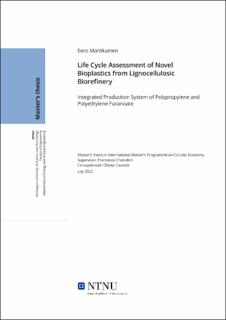| dc.description.abstract | This Thesis is a state-of-art study in which an integrated, raw material-efficient, biorefinery production system was designed for the combined production of bio-PP and PET. The aim was to find out how the environmental impacts of these bioplastics compare to their fossil alternatives and whether the high raw material efficiency is beneficial in terms of environmental impacts. In addition, the importance of energy sources was evaluated by modelling the environmental impacts with a system based on three different energy sources: wood chips, natural gas and coal.
The environmental assessment was based on the cradle-to-gate Life-Cycle Assessment (LCA). In the initial scenario based on wood chips as an energy source, bio-PP resulted in a GWP of 0,81 kg of CO2 eq. and the PEF resulted in a GWP of 2,17 kg of CO2 eq and in general the initial scenario performed well compared to scenarios based on natural gas and coal as an energy source.
The main finding of the study was that a high material-efficient biorefinery requires large amounts of energy and therefore the choice of the energy sources is a crucial factor in determining the environmental impacts related to the products. When wood chips were used, the products performed well compared to the fossil alternatives but when natural gas or coal was applied, the impacts on many categories were remarkably higher than the ones related to the fossil alternatives. The good performance of the wood chips as an energy source is based on the exclusion of biogenic GHG emissions which is an important factor to consider. The exclusion of biogenic GHG emissions on the other hand is dependent on the renewable energy status of wood combustion which is, therefore, a crucial factor in determining the environmental performance of the products and the biorefinery system as a whole.
To conclude, if wood combustion was not considered renewable energy, either another renewable energy source should be used or then the biorefinery should be designed in the conventional way in which enough sidestreams for energy production are produced to cover the energy source demand. | |
